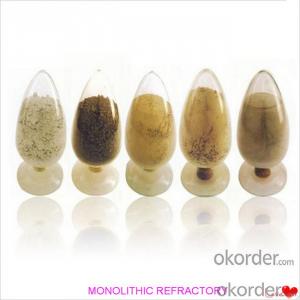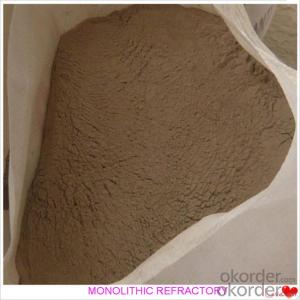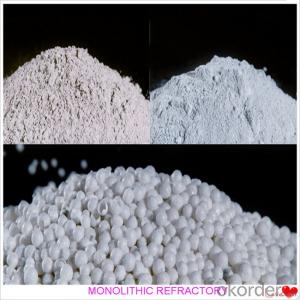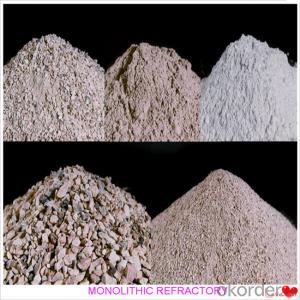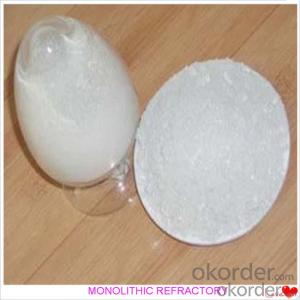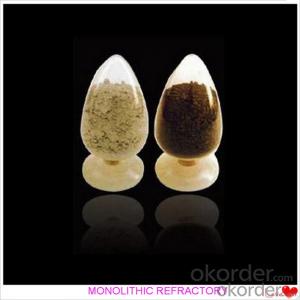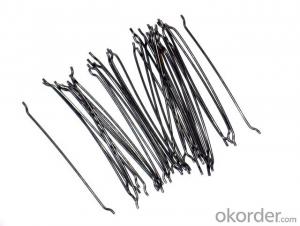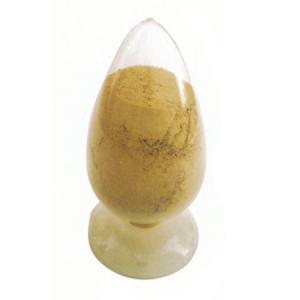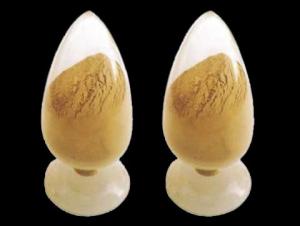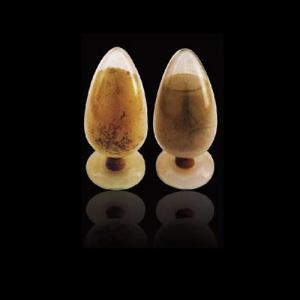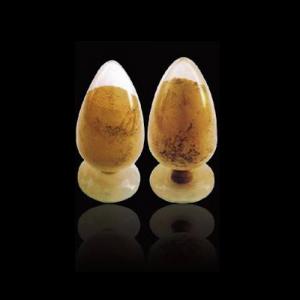Mesh Shape Castable For Fireplace and Industrial Furnace
- Loading Port:
- China main port
- Payment Terms:
- TT OR LC
- Min Order Qty:
- 1000 kg
- Supply Capability:
- 3000000 kg/month
OKorder Service Pledge
OKorder Financial Service
You Might Also Like
Mesh Shape Castable For Fireplace and Industrial Furnace
Product Description:
Mesh shape castable is manufactured according to international standards. The product is famous for its excellent abrasion resistance and low thermal conductivity. Further, these can be provided in different specifications as required by the clients. The Mesh shape castables are used high purity raw materials and additives as the main material, and made of under superfine powder adding technology.
Product Advantages:
The material has excellent structural stability and air tightness, and has high physical and chemical properties, also has a fine working ability.They should be used with the same material products.They are widely used in various kinds of kiln lining.Such as boiler, blast furnace hot blast stove, heating furnace, ceramic kiln, etc.Furnaces of metallurgy industry, heat treatment furnace. Furnace of incineration of garbage, recirculating fluidized bed furnace. Furnaces of chemical industry and construction industry.
Product Applications:
For feature of Mesh shape castable, they have excellent abrasion resistance, thermal shock resistance, high-temperature resistance, anti-corrode and have high intensity.
Designed for refractory lining of blast furnace iron and slag runners, skimmers and soon
They can be used in troughs of small and mid size BFs and in all positions of the troughs where fast tapping is required.
Main Product Features:
1. High refractoriness, High refractoriness under load.
2. High density, low porosity.
3. Good slag resistance and corrosion resistance.
4. High strength and wear resistance.
5. Good resistance to flake performance.
6. Good thermal shock stability.
7. Scouring resistance
8. Good hot strength.
Product Specifications:
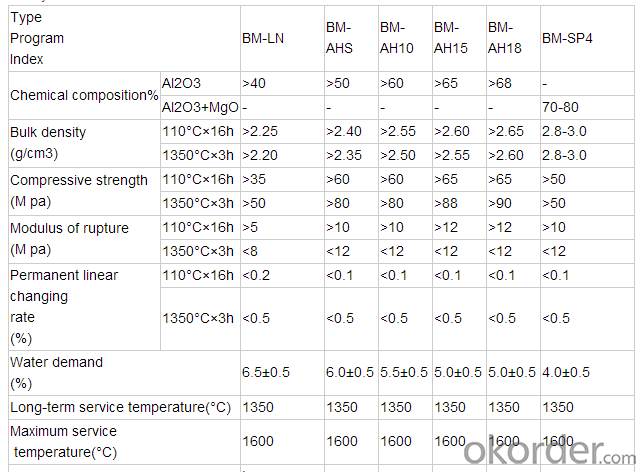
FAQ:
1. How you can control your quality?
For each production processing, we have complete QC system for the chemical composition
and Physical properties. After production, all the goods will be tested, and the quality certificate
will be shipped along with goods.
2. What's your delivery time?
It usually needs about 20days- 45 days after receiving the deposit.
3. Do you provide free samples?
Yes, we can provide a free sample for testing, If we have sample in stock,
The quantity based on the material type, The buyer should bear all the shipping costs.
4. What's your payment terms?
We can accept 30% deposit, 70% balance before shipment for ordrs over $ 2000.
5. Can we visit your Company?
Yes, certainly. You are very welcome to China and we will be honored to have a customer and friend.
Product Picture:



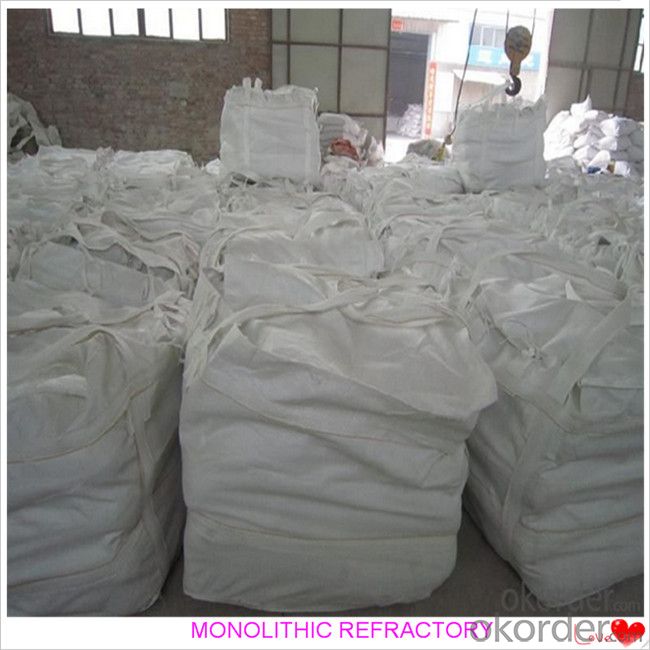
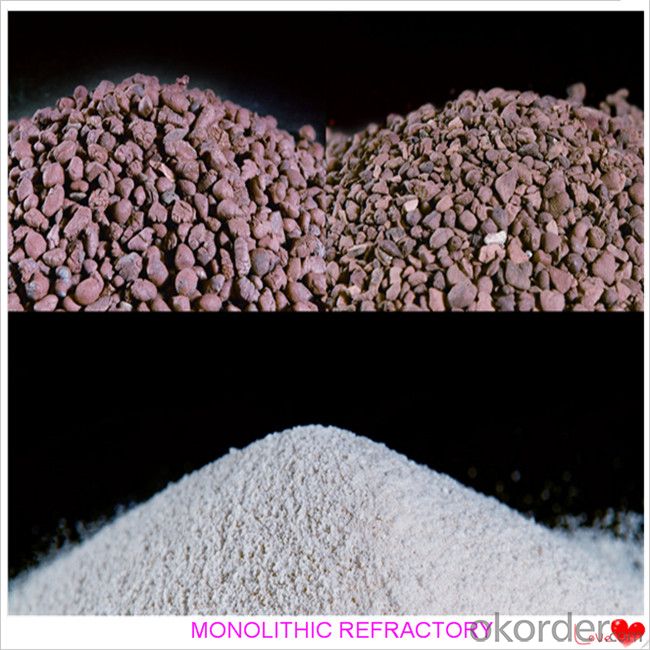
- Q:How do monolithic refractories improve the quality and consistency of iron and steel products?
- Monolithic refractories enhance the quality and consistency of iron and steel products by providing excellent resistance to high temperatures, thermal shock, and chemical attacks. These refractories form a seamless lining within the furnaces and other equipment used in the production process, ensuring optimal insulation and minimizing heat loss. This insulation helps in maintaining stable and controlled temperatures, preventing unwanted variations that can affect the final product's quality. Additionally, monolithic refractories' durability and resistance to wear and tear contribute to consistent and reliable performance, resulting in improved iron and steel product quality.
- Q:How do monolithic refractories prevent slag penetration?
- Monolithic refractories prevent slag penetration through several mechanisms. Firstly, monolithic refractories are made up of high-quality materials that have excellent resistance to slag attack. These materials, such as alumina, silica, and magnesia, have a high melting point and can withstand the corrosive nature of the slag. Secondly, monolithic refractories are designed with a dense and compact structure that minimizes the porosity. Slag penetration occurs when the molten slag infiltrates the pores and cracks of the refractory material. By reducing the porosity, monolithic refractories create a barrier that restricts the entry of slag into the refractory lining. Additionally, monolithic refractories can be chemically bonded to the substrate, forming a strong and impermeable bond. This bond further enhances the resistance to slag penetration by preventing any gaps or weak points where the slag can penetrate. Moreover, monolithic refractories can be designed with a high thermal shock resistance. Slag penetration is often intensified by thermal cycling, where the refractory material undergoes rapid temperature changes. Monolithic refractories with high thermal shock resistance can withstand these temperature fluctuations without cracking or spalling, thus reducing the risk of slag penetration. Furthermore, the proper installation and maintenance of monolithic refractories play a crucial role in ensuring their effectiveness against slag penetration. The refractory lining needs to be properly designed, using appropriate thickness and geometry, to provide maximum protection against slag attack. Regular inspection and repair of any damaged or worn-out areas can also prevent slag penetration. In conclusion, monolithic refractories prevent slag penetration through their excellent resistance to slag attack, dense structure, chemical bonding, high thermal shock resistance, and proper installation and maintenance. These factors work together to create a strong and impermeable barrier that protects the underlying substrate from the corrosive effects of slag.
- Q:How do monolithic refractories perform in blast furnace taphole applications?
- Monolithic refractories perform exceptionally well in blast furnace taphole applications due to their unique characteristics and properties. Firstly, monolithic refractories are known for their superior thermal resistance. Blast furnace tapholes are exposed to extremely high temperatures and thermal shocks, making it essential to have a refractory material that can withstand these conditions. Monolithic refractories have high refractoriness, meaning they can maintain their structural integrity even at elevated temperatures, ensuring the taphole remains functional. Secondly, monolithic refractories have excellent erosion and corrosion resistance. In blast furnace taphole applications, the refractory material is constantly exposed to molten metal, slag, and gases that can cause erosion and chemical reactions. Monolithic refractories are designed to resist these aggressive environments, minimizing wear and extending the service life of the taphole. Furthermore, monolithic refractories offer good thermal conductivity and insulation properties. This is crucial for blast furnace tapholes as they need to maintain a consistent and controlled flow of molten metal. The refractory material must be able to transfer heat efficiently while also providing insulation to prevent excessive heat loss, ensuring optimal performance and productivity of the blast furnace. Additionally, monolithic refractories are easy to install and repair. Blast furnace tapholes require regular maintenance due to the harsh conditions they are subjected to. Monolithic refractories can be easily shaped and applied, allowing for quick repairs or replacement of damaged areas. This reduces downtime and increases the operational efficiency of the blast furnace. In summary, monolithic refractories are highly suitable for blast furnace taphole applications due to their excellent thermal resistance, erosion and corrosion resistance, good thermal conductivity and insulation properties, as well as ease of installation and repair. These characteristics make them a reliable and effective choice for maintaining the functionality and performance of blast furnace tapholes.
- Q:How are monolithic refractories different from traditional refractories?
- Monolithic refractories differ from traditional refractories in terms of their composition, installation method, and performance characteristics. To begin with, monolithic refractories consist of only one material, as their name suggests, while traditional refractories are typically comprised of multiple materials. This singular composition of monolithic refractories allows for greater control over their properties and performance. Moreover, the installation process for monolithic refractories differs from that of traditional refractories. Traditional refractories are typically installed in the form of bricks or precast shapes, which are assembled together to create the desired lining. In contrast, monolithic refractories are provided in a ready-to-use form, such as a dry mix or suspension, which is then poured, sprayed, or gunned into place. This facilitates a faster and more efficient installation of monolithic refractories. Lastly, monolithic refractories offer superior performance characteristics compared to traditional refractories. They possess improved thermal shock resistance, higher hot strength, and enhanced resistance to chemical attacks. Furthermore, they can be more easily repaired or patched compared to traditional refractories, which often necessitate the replacement of entire bricks or shapes. In conclusion, the key distinctions between monolithic refractories and traditional refractories lie in their composition, installation method, and performance characteristics. Monolithic refractories provide better control over properties, simpler installation, and superior performance, making them the preferred choice in numerous industrial applications.
- Q:What are some common applications of monolithic refractories in the iron and steel industry?
- Due to their superior performance and versatility, monolithic refractories find wide application in the iron and steel industry. In this industry, these refractories serve various purposes, such as: 1. Blast Furnace: To withstand high temperatures and chemical reactions, blast furnaces employ monolithic refractories in their linings. These refractories maintain the structural integrity of the furnace and provide insulation against heat loss. 2. Ladle Lining: Monolithic refractories line ladles, which transfer molten iron or steel from the blast furnace to the steelmaking process. They exhibit excellent resistance to thermal shock and erosion caused by the aggressive molten metal. 3. Tundish Lining: Tundish, an intermediate vessel that distributes molten steel to multiple casting molds, utilizes monolithic refractories in its lining. This ensures proper thermal insulation and prevents steel contamination during casting. 4. Electric Arc Furnace (EAF): The lining of EAFs, used in the steelmaking process, consists of monolithic refractories that withstand extreme temperatures and chemical reactions. They exhibit remarkable resistance to high heat and erosion caused by the molten metal and slag. 5. Induction Furnace: Monolithic refractories are also used in the lining of induction furnaces, which melt and refine metals. They provide insulation and protect the furnace structure from the high temperatures and chemical reactions occurring during the melting process. 6. Continuous Casting: Continuous casting machines require monolithic refractories in their linings to ensure smooth and consistent casting of molten steel. These refractories display excellent resistance to high temperatures, thermal shock, and erosion caused by the molten metal and slag. In summary, monolithic refractories play a crucial role in the iron and steel industry by enhancing the overall efficiency and productivity of the manufacturing process. They achieve this by providing durability, thermal insulation, and resistance to chemical reactions.
- Q:How does the choice of monolithic refractory impact the overall cost of iron and steel production?
- The choice of monolithic refractory can have a significant impact on the overall cost of iron and steel production. Monolithic refractory refers to a type of refractory material that is installed in a continuous manner, as opposed to traditional brick or tile refractories. One key factor that affects the cost of iron and steel production is the lifespan of the refractory. Monolithic refractories generally have a longer lifespan compared to traditional brick or tile refractories. This means that they require less frequent maintenance and replacement, resulting in lower overall costs over time. Additionally, monolithic refractories have a higher resistance to thermal shock and mechanical stress, which further extends their lifespan and reduces the need for repairs and replacements. Another important consideration is the energy efficiency of the monolithic refractory. These refractories have better insulation properties, which leads to reduced heat loss during the iron and steel production process. This helps to lower energy consumption and, consequently, the overall cost of production. The improved insulation also contributes to a more stable and controlled temperature profile within the furnace, resulting in better product quality and reduced scrap rates. Furthermore, monolithic refractories offer greater flexibility in terms of installation and repair. They can be easily applied to complex shapes and structures, allowing for more efficient use of refractory materials. This reduces waste and lowers material costs. The ease of installation also saves time and labor, further contributing to cost savings. Additionally, monolithic refractories are known for their superior performance in high-temperature environments. They exhibit excellent thermal conductivity and resistance to chemical attacks, ensuring optimal furnace operation and reducing the likelihood of downtime and production delays. This, in turn, minimizes the impact of unexpected maintenance, repairs, and shutdowns on the overall cost of iron and steel production. In conclusion, the choice of monolithic refractory can have a significant impact on the overall cost of iron and steel production. Its longer lifespan, improved energy efficiency, ease of installation and repair, and superior performance in high-temperature environments all contribute to cost savings in various aspects of the production process. Thus, careful consideration of the type of monolithic refractory used can result in significant cost reductions and improved overall efficiency in iron and steel production.
- Q:How do monolithic refractories resist thermal shock in the iron and steel industry?
- Monolithic refractories are specifically designed to resist thermal shock in the iron and steel industry. This is primarily achieved through their unique composition and structure. Firstly, monolithic refractories are made from high-quality raw materials, such as alumina, magnesia, and silica, which have excellent thermal properties. These materials are carefully selected to provide a high melting point, low thermal conductivity, and good thermal expansion characteristics. Secondly, the manufacturing process of monolithic refractories involves precise control of the grain size distribution and the addition of bonding agents. This results in a dense and homogeneous structure, which enhances their resistance to thermal shock. The bonding agents also play a crucial role in enhancing the refractory's strength and integrity. Additionally, monolithic refractories are often formulated with additives that provide increased resistance to thermal shock. These additives can include zirconia, silicon carbide, or graphite, which improve the refractory's ability to withstand rapid temperature changes. Moreover, monolithic refractories are designed to have low porosity, reducing the penetration of molten metal or slag into the material. This helps to prevent the formation of cracks and spalling, which can occur due to thermal shock. Furthermore, monolithic refractories are often applied as a lining or coating on the surface of the furnace or other equipment. This allows them to form a protective barrier, reducing direct exposure to extreme temperatures and thermal cycling. Overall, the combination of high-quality raw materials, careful manufacturing processes, additives, low porosity, and proper application techniques make monolithic refractories highly resistant to thermal shock in the iron and steel industry. They can withstand rapid temperature changes, prevent cracks, and maintain their structural integrity, ensuring reliable and efficient operation of furnaces and other equipment in this demanding industry.
- Q:What are the factors to consider when selecting monolithic refractories for specific applications?
- When selecting monolithic refractories for specific applications, there are several factors that need to be considered. These factors include the operating temperature, chemical environment, mechanical stress, and the desired performance characteristics of the refractory material. The operating temperature is a crucial factor to consider as different monolithic refractories have different temperature limits. It is important to choose a refractory material that can withstand the specific temperature range of the application without suffering from thermal spalling or degradation. The chemical environment in which the refractory will be exposed is another crucial factor. Different applications may involve exposure to various chemicals, acids, alkalis, or gases. It is essential to select a monolithic refractory that is chemically resistant to the specific environment to ensure prolonged durability and performance. Mechanical stress is also an important consideration when selecting monolithic refractories. Some applications may involve high mechanical stress such as abrasion, impact, or thermal shock. It is crucial to choose a refractory material that can withstand these stresses without cracking or failure. The desired performance characteristics of the refractory material should also be taken into account. This includes factors such as thermal conductivity, thermal expansion, density, and strength. The application requirements will dictate the specific performance characteristics needed, and the refractory material should be chosen accordingly. Other factors to consider include installation method, availability, cost, and maintenance requirements. Some monolithic refractories may require specialized installation techniques, while others may be more readily available and cost-effective. Additionally, the maintenance requirements of the refractory material should be considered to ensure ease of upkeep and longevity. Overall, selecting the right monolithic refractories for specific applications requires careful consideration of factors such as operating temperature, chemical environment, mechanical stress, desired performance characteristics, installation method, availability, cost, and maintenance requirements. By considering these factors, one can choose the most suitable refractory material that will provide optimal performance and durability in the given application.
- Q:What are monolithic refractories and how are they different from other refractory materials?
- Monolithic refractories are a type of refractory material that are composed of a single, homogeneous structure, as opposed to being made up of multiple separate pieces. They are different from other refractory materials, such as bricks or tiles, which are assembled together to form a lining. Monolithic refractories are typically made from a combination of aggregates, binders, and additives, which are mixed together and applied in a plastic or semi-plastic state. This allows for easier installation, as they can be shaped and formed to fit the specific dimensions of the furnace or kiln. Additionally, monolithic refractories offer benefits such as better thermal shock resistance, reduced joints and seams, and improved overall performance due to their seamless nature.
- Q:How do monolithic refractories withstand high temperatures in iron and steel production?
- Monolithic refractories are able to withstand high temperatures in iron and steel production due to their composition and unique properties. These refractories are made from a single, continuous material, which eliminates the need for joints or seams that could weaken under extreme heat. Additionally, they have high thermal conductivity and low thermal expansion, allowing them to effectively absorb and distribute the intense heat in the production process without cracking or breaking. Furthermore, monolithic refractories are highly resistant to chemical corrosion and erosion, which is crucial in the harsh environment of iron and steel production. Overall, the combination of these factors enables monolithic refractories to withstand the extreme temperatures involved in iron and steel production.
1. Manufacturer Overview |
|
|---|---|
| Location | |
| Year Established | |
| Annual Output Value | |
| Main Markets | |
| Company Certifications | |
2. Manufacturer Certificates |
|
|---|---|
| a) Certification Name | |
| Range | |
| Reference | |
| Validity Period | |
3. Manufacturer Capability |
|
|---|---|
| a)Trade Capacity | |
| Nearest Port | |
| Export Percentage | |
| No.of Employees in Trade Department | |
| Language Spoken: | |
| b)Factory Information | |
| Factory Size: | |
| No. of Production Lines | |
| Contract Manufacturing | |
| Product Price Range | |
Send your message to us
Mesh Shape Castable For Fireplace and Industrial Furnace
- Loading Port:
- China main port
- Payment Terms:
- TT OR LC
- Min Order Qty:
- 1000 kg
- Supply Capability:
- 3000000 kg/month
OKorder Service Pledge
OKorder Financial Service
Similar products
New products
Hot products
Hot Searches
Related keywords
